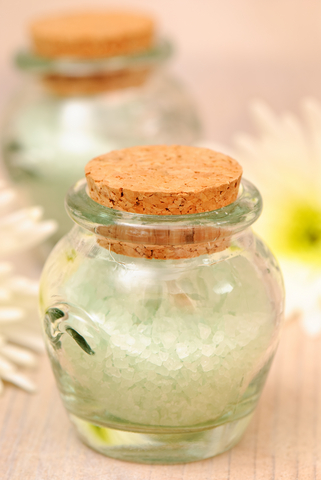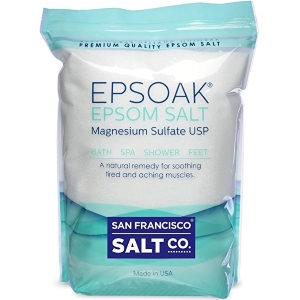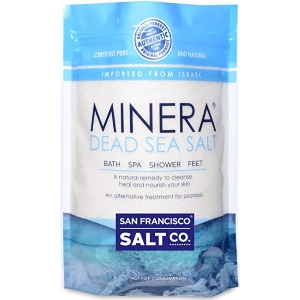There are thousands of articles on homemade bath salts on the internet. Unfortunately, there’s a lot of misinformation and hype out there in the cyber world as marketers try and sell you their products. You’re not going to find that here. In fact, you’re never going to find that on this site. We think our readers deserve better. Ready, set, let’s do some exploring into the ingredients that go into homemade bath salts!
Sea Salt
What you sprinkle on your celery or mashed potatoes is a salt. It’s purified sodium chloride (NaCl). Sodium chloride is the primary salt found in our oceans. In fact, roughly 80% of the minerals in seawater consist of sodium chloride. It’s primarily the other minerals that benefit your skin. That’s why you should use sea salt rather than table salt in homemade bath salts.
Not that you care, but we’re going to tell you anyway. To produce sea salt, the water is evaporated away leaving the salt and residual minerals. It is sold as Pacific sea salt, Mediterranean sea salt, etc. However, regardless of where the salt comes from, the bulk of what you are buying is sodium chloride.
When making homemade bath salts, the main benefit of adding sea salt is its ability to help prevent prunification (my word). Who likes wrinkled up toes and fingers?
Epsom Salts
There are numerous benefits of Epsom salts for homemade bath salts. In fact, there are too many to cover here, so to get the full skinny on this marvelous (and cheap) bath salt click here.
Dead Sea Salt
Dead Sea salt, like Epsom salts, have so many benefits that we have made a separate article dedicated to Dead Sea salt. To read the full story on Dead Sea salt click here.
Sodium Bicarbonate
Sodium bicarbonate, better known as baking soda is an interesting salt in that it forms carbonic acid and an hydroxide ion in water making the solution slightly alkaline. Carbonic acid neutralizes bases and the hydroxide ion neutralized acids. Keep in mind that carbonic acid is extremely weak and very unstable when exposed to water (it converts to carbon dioxide gas and water), therefore it may lose much of its ability to effectively neutralize a base when exposed to the natural humidity in the air. Sodium bicarbonate can be produced by adding sodium hydroxide (NAOH) (a strong base) with carbon dioxide (CO2) which gives you sodium carbonate (soda ash) and water (Na2CO3 + H2O). When you add more carbon dioxide, you get sodium bicarbonate (2 Na2CO3). Now that’s enough chemistry for now, let’s move onto the uses for baking soda. Suffice it to say that sodium bicarbonate is indeed a very interesting substance.
Baking soda will neutralize the pH of water. Internally, sodium bicarbonate is an important component in our blood chemistry. In addition, it is used as an antacid. Externally, sodium bicarbonate is used to treat poison ivy, oak and sumac and other rashes and as an exfoliant. It is also used as a treatment for hemorrhoids. However, in homemade bath salts, its primary function is to soothe rough skin.
Borax
We don’t recommend using borax in bath water. Borax softens bath water and is often used in homemade bath salts, however, borax can be absorbed through the skin. Borax may be toxic (causes liver damage), it’s best not to use it in your bath. However, it’s antifungal properties may make it useful as an occasional foot bath.
Borax shouldn’t be used in homemade bath salts. But wait, there’s two more. Sodium hexametaphosphate is a heavy duty water softener that is used in some bath salts. Its dry form can be irritating to sensitive skin. Sodium Sesquicarbonate also used in some bath salts can cause skin irritation and the dust may be an irritant to mucus membranes and the upper respiratory tract. Hey, you don’t need to use these salts anyway.
In summary, here’s what we know. To simply soothe your skin, you can make homemade bath salts with baking soda alone. To enjoy the many benefits that magnesium affords, use either Dead Sea salts and/or Epsom salts. We recommend using a combination of Dead Sea salt and Epsom salts. These two salts will afford you the maximum benefit of increased magnesium, potassium and sulfate in your bath. (Be sure and read the more extensive articles on the benefits of Dead Sea salts and Epsom salts.) Regardless of which salt or combination you use, be sure to rinse your skin well after your bath.
If you stick with sodium bicarbonate (baking soda), Dead Sea salt, and Epsom salts, you can make the perfect bath salt that will benefit your body the most. No troubles for our readers!!
Three Basic Homemade Bath Salts
- To make bath salts with Epsom salts, add 1 to 2 cups to a full bath.
- To make bath salts with Dead Sea salt, add 1 to 2 cups to a full bath. Higher concentration of this salt are needed for treating psoriasis and other skin conditions such as eczema
- To add bath salts with baking soda, add ½ cup to a full bath.
For more great recipes, check out the related articles below.
Now go have fun and relax.
Recommended products:
Epsoak Epsom Salt Magnesium Sulfate USP, 5lbs Bulk Bag Minera Dead Sea Salt 2lb Bag Fine Grain, 100% Pure Mineral Salt Treatment
Minera Dead Sea Salt 2lb Bag Fine Grain, 100% Pure Mineral Salt Treatment
Related articles:
Bath Salts for Dry Skin
Homemade Bath Salts – Lavender
3 Amazing Bath Salt Recipes
Dead Sea Salt Benefits




Hi there Guest,
Thanks for the question. It’s a good one and it gives me the opportunity to clarify a few things regarding soda ash.
Burnt vegetation is used to make soda ash by adding carbon dioxide which then gives you sodium carbonate (soda ash). What you get from simply burning the vegetation is sodium hydroxide. Sodium hydroxide can chew through your skin right to the bone, sodium carbonate will not.
If you are making soap, you can create the lye for the process by burning vegetation and then submitting the ash to a lengthy filtering process. There are a few sites with instructions on how to do this.
I did find some recipes for making soda ash from baking soda. You might want to give that a try. I have not done this, so can’t report on the validity of the recipes.
Hi there,
Thank you for commenting. In response, please read previous comments similar to yours and my response.
Hope to hear from you again.
Although none of us here at SpaFromScratch are expert gardeners, I did find some information for you and me. This last year was my first year of planting raised bed vegetables. I also encountered similar issues with my plants. Here are a few links that you may find helpful:
http://gardening.about.com/od/problemspests/tp/Radish-Growing-Problems.htm
http://www.gardeningknowhow.com/edible/vegetables/broccoli/bolting-broccoli-growing-broccoli-in-hot-weather.htm
http://www.vegetable-gardening-made-simple.com/how-to-grow-broccoli.html
I hope this helps 🙂
Hello wonderful goddess,
Sorry you felt the need to slap me around. That really wasn’t necessary. I’m also sorry you felt that I was trying to falsely pass the information as truth. I assure you I would never do that.
You are absolutely correct in identifying me as not an expert. No one can have such a vast array of knowledge as to be an expert in all fields. However, in my defense, all posts in Spa From Scratch are as carefully researched as is possible in order to make them as reliable as possible.
I review all the evidence I can find and make recommendations based on those findings. And yes, I do tend to err on the side of caution if there is any question and I shall continue to do so.
You are also absolutely correct in stating that the scientific studies on animals include dosages of borax far above those that would be normally consumed by either humans or animals. However, there have been sufficient studies and opinions of scientific community relating to the negative effects of borax that I stand with my original conclusion. I have included two for you to check out.
Here are a few unknowns:
1 Studies indicate low skin absorption, they do not indicate how much boron is absorbed.
2 Studies indicate average boron found in some subjects to be fairly low. However, that number may increase dramatically in areas where higher boron is found in water supplies or food.
3 A nice bath using a bath salt containing borax might be fine for the person taking a long bath once a week, but it’s unknown what affect taking a daily long soak may have.
4 Some studies indicate that boron is beneficial in preventing bone loss, but increased hot flashes in post menopausal women. One study indicated that boron had a negative effect on enzyme metabolism at the cellular level. Result – benefits and toxicity unknown.
5 Excess boron is apparently stored in the bone, but the long term effect is unknown.
I could go on an on, but I’ll leave it here.
Allow me to make just one more comment on accepting the FDA’s evaluation as gospel. If you remember, Thalidomide was approved by the FDA with dire consequences for many families.
I’ll close with this. Thank you again for commenting here. We appreciate the opinions of our readers and I apologize if I offend anyone. That is not the intent.
—————–
From: http://www.enviroblog.org/2011/02/borax-not-the-green-alternative-its-cracked-up-to-be.html
Borax: Not the green alternative it’s cracked up to be
February 17, 2011
Rebecca Sutton, PhD, EWG Senior Scientist
2. Personal care products
Boric acid or sodium borate can also be found in personal care products. The cosmetic industry’s own safety panel states that these chemicals are unsafe for infant or damaged skin, because they can absorb readily into the body. Despite this guidance, boric acid is found in some diaper creams. See EWG’s Skin Deep cosmetics database for other personal care products containing borax or boric acid and click here for diaper creams that don’t contain it.
Both the European Union and Canada restrict these ingredients in body care products made for children under three years of age and require that products containing these ingredients be labeled as not appropriate for broken or damaged skin. No similar safety standards are in place in the United States.
————–
From: http://www.env.gov.bc.ca/wat/wq/BCguidelines/boron/boron.pdf
4. Bioaccumulation and Biomagnification
Bioaccumulation and biomagnification of boron in the environment is not clearly
understood. There are numerous studies indicating no evidence of either of these, as well
as studies indicating evidence of such action.
In general, the literature suggests that aquatic environments are not likely to experience
boron bioaccumulation or biomagnification (Wren et al., 1983; Butterwick et al., 1989).
In particular, studies performed by Thompson et al., (1976) found no evidence of active
bioaccumulation of boron in sockeye salmon (Oncorhynchus nerka) tissues or Pacific
oyster (Crassostrea gigas). In the salmon, they found that tissue boron levels were not
vastly different from water boron levels. In the Pacific oyster, it was apparent that tissue
concentrations approximated the levels in the water within 36 days exposure. However,
following the cessation of dosage, tissue boron levels returned to background levels by the
71st day of the study.
It has been found that migratory and resident birds bioaccumulated boron in their tissues,
apparently from irrigation drainwater contamination. Setmire et al.(1990) conducted
biological sampling and analysis that showed drainwater contaminants such as selenium,
boron and DDE were accumulating in tissues of migratory and resident birds using the
food sources in the Imperial Valley and Salton Sea, California. Boron concentrations
were at levels that potentially could cause reduced growth in young. Boron appears to
bioaccumulate in mammals, as seen from studies by Weir and Fisher (1972) and Beyer et
al.(1983). Weir and Fisher (1972) found that toxic effects of boron included male
infertility in rats and dogs due to accumulation and cytotoxic effects on germinal tissues
in the testes with over 1 000 mg/kg boron equivalents (in diet). Beyer found that boric
acid accumulated in the brain, spinal cord and liver after ingestion.
Absolutely fabulous god,
Thank you for your comment and interest. With all the conflicting studies on various topis in the posts here at Spa From Scratch, it’s enough to make my head blow up at times. Perhaps I should try a Zoloft bath also.
Feel free to comment on this site any time. We’re delighted to hear from you.
Your friend,
Vic
Thank you. It’s great to be appreciated.
Love,
Lori and Vic
Hello frustrated one,
If you added fresh rosemary, you added water from the plant. Water added to sodium bicarbonate (baking soda) gives off CO2 (carbon dioxide gas). That’s probably what caused the plastic jars to split and the bags to get puffy. Open the bags to allow the gas to escape and your bath salts will be okay.
Have a wonderful holiday,
Vic
A 1/2 cup of Borax is added to bath water is 100% safe as our body uses the trace element of boron absorbed thru the skin. Now if you mixed a 1/2 cup of borax in water and then drank it then yes it would cause liver dammage. It turns out table salt is also dangerous if swallowed and we use that in our bath. If one drank 1 cup of salt mixed in water that could be fatal but we don’t have people telling us not to use salt.
Thank you so much for your comment. We love to hear from our readers.
Here’s my take on the borax issue. You are absolutely right in that 1/2 cup of borax in bath water is not toxic. In fact, boron is one of those trace minerals needed in our bodies. However, since boron is found in water supplies and since boron is bio-accumulative in mammals and since total absorption through the skin with long or frequent soaks is unknown, I stand on my conclusion that it’s best not to use it in bath salts.
As a side note, it’s also not environmentally friendly.
I know I have the mother hen syndrome in that I usually tend to be very cautious in what I recommend you use in your formulations. That’s because I love you very deeply and want to keep you safe.
sodium bicarb is not an acid
Sorry, my wording was misleading. You’re right, it is not an acid, it’s a salt. What I meant to say was that when it is dissolved in water it becomes an acid (carbonic acid) and a base (OH ions).
I fixed the problem. Thank you so much for pointing that out.